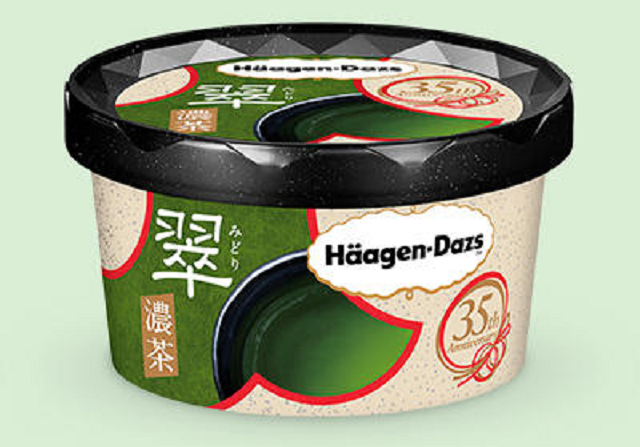We’re still enjoying the culinary afterglow of our all-matcha multi-course Häagen-Dazs meal in Tokyo’s swanky Roppongi neighborhood, but if we’ve learned one thing in life, it’s that you can’t spend too much time living in the past. And so we now bravely turn our hearts and minds to the future, specifically to July.
That’s the date that Häagen-Dazs Japan will release its 35th anniversary flavor, and it’s appropriately chosen a very special kind of green tea to mark three and a half decades in the country. Called Midori Koicha, the flavor’s name translates to “Green Deep Tea,” and it comes in a unique container decorated with the image of a mizuhiki celebratory cord.
But what’s really important, of course, is what’s inside the container. For this milestone release, Häagen-Dazs isn’t using just any matcha. The tea that goes into the ice cream is entirely hand-picked, first-harvest leaves, which are shaded for more than 35 days when growing to enhance their flavor. That’s even longer than the 20 or so days of shaded growth that’s the norm for gyokuro, one of the most prized, and expensive, types of green tea in all of Japan.
Once these premium-quality leaves have been harvested, Häagen-Dazs uses an extra-large quantity for the Midori Koicha. The company is promising a rich and complex taste sensation that balances the sweet and bitter notes that harmoniously coexist in the finest Japanese teas, and we’re already looking forward to this edible 35th anniversary party.
Midori Koicha will be priced at 350 yen, and goes on sale at supermarkets and convenience stores on July 9, so that’s the day to circle on your calendar (preferably in green ink).
Source: Häagen-Dazs via Entabe
Read more stories from SoraNews24.
-- Häagen-Dazs awesome hojicha latte is a whole new way to love Japanese tea ice cream
-- Häagen-Dazs new Japanese ice cream looks freaky, tastes great
-- Does Häagen-Dazs’ Matcha Green Tea Crumble deliver on its high-class name’s promise? 【Taste test】
- External Link
- https://soranews24.com/2019/05/18/haagen-dazs-japans-35th-anniversary-green-deep-tea-ice-cream-is-no-ordinary-matcha-dessert/
 Take our user survey and make your voice heard.
Take our user survey and make your voice heard.















10 Comments
Login to comment
Strangerland
It's one meaning of the word, generally used in reference to color, or taste.
Acctually, it's an accurate translation of the word 濃い. But even if it wasn't, direct translations generally end up sounding silly in the other language, and more of then than not, a direct translation is a poor one when doing marketing, so even if 'deep' wasn't a correct translation of 濃い, the translation could still be a good one if it were more appropriate than the direct translation.
Strangerland
Actually for taste, I think we would translate 濃い (koi) as 'strong' rather than deep.
But 濃い色 (こいいろ - koi iro) is accurately translated a 'deep color'.
3RENSHO
'Deep' can be used to describe the taste of wine -- from Wikipedia:
Depth: A wine with several layers of flavor. An aspect of complexity.[11]
Strangerland
Personally, I think deep is the correct translation in this case. Strong doesn't seem like the right thing to convey when talking about a tea flavor (濃茶). I think 'deep' is more appropriate for tea, and 3rensho's definition expresses why.
kurisupisu
So koi in English means deep?
Casey’s automatic translation sofuto must be getting tired.
kurisupisu
Exactly, nobody describes a taste as deep, do they?
A ‘strong’ taste is what Casey should have written.
Her translation is not accurate in this article’s context.
Strangerland
I still think ‘deep’ is a more accurate translation in relation to tea. Thick does not come across right. I also wouldn’t translate 薄茶 as thin tea either.
These translations are direct, but often direct translations between English and Japanese end up coming off unnatural in the other language. I think this is one such case where the context needs to be considered to come up with an appropriate translation. And in this case I think they’ve chosen a good translation with ‘deep’.
RonriiUrufu
濃い is a wonderful word to describe intensity. It means thick (beard, fog, make-up), dark (colours), close (relationship), strong (taste, drinks) and even sensual. Great example for the Japanese language being build on context rather than having precise words for everything.
kurisupisu
Put it to the test?
Visit an English speaking country and remark that you had some ‘deep tea’ for breakfast.